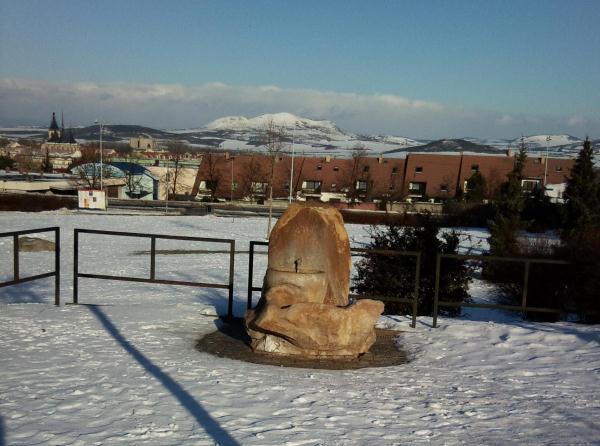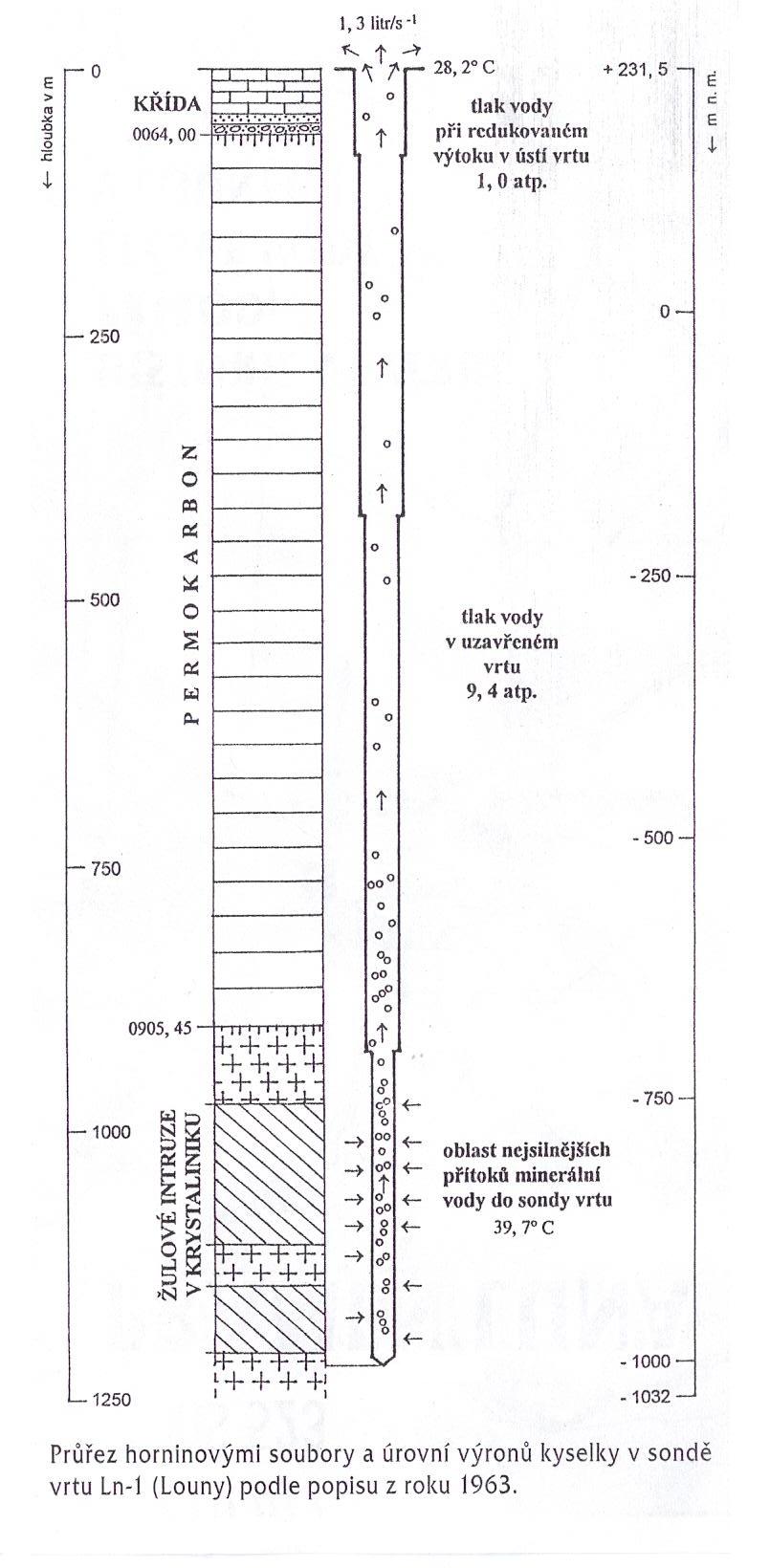

Pramen Luna
Pramen Luna je nejhlubším minerálním pramenem v Ceské
republice. Jeho jedinecné složení je porovnatelné pouze s
minerálními prameny ve známých francouzských lázních Vichy a s
prameny z prírodního parku Borjomi v Gruzii. Na rozdíl od techto
minerálních pramenu v dalekých lázenských mestech není minerální
voda z pramene Luna známá ani v nejbližším okolí mesta
Louny a pro lécebné kury je používána pouze ve meste
samém.
Úvodní souradnice vás dovedou k jednomu z vyústení pramene Luna
v Lounech, když toto vyústení je jako jediné prístupné v
jakoukoliv denní ci nocní hodinu bez omezení.
Historie a geologie:
Oblast jihozápadního okraje Ceského stredohorí s telesy
tretihorních vulkánu a se zlomy, ohranicujícími poklesy
postiženou krajinu mezi Krušnými horami a Ceskou
krídovou tabulí, je místem, kde v podloží krídových a
permokarbonových usazenin drímají zdroje teplých lécivých vod.
Dukazy o tomto bohatství hlubin krajiny Poohrí poskytl i hlubinný
vrt, provedený zacátkem šedesátých let v jižní cásti
katastru mesta Louny.
Vrt:
Pri pátrání po možných zásobách cerného uhlí v hlubokém
podloží ohárecké krídy na Lounsku byl proveden geologický
strukturní vrt Ln-1. Vrtání zapocalo v ríjnu 1962 a již v
breznu 1963 byl v hloubce okolo 1 100 m zastižen silný výron
podzemní termální vody s vysokým obsahem oxidu uhlicitého,
dosahujícího pulzujícího prelivu 1,6 m nad ústí vrtu. Koncem srpna
1963 byly vrtné práce zastaveny v hloubce presahující 1 200 m.
Behem následujících let byly provedeny úpravy pramene a jeho okolí,
které vyvrcholily dne 6. kvetna 1975 slavnostním otevrením
zastrešeného pavilonu s pulzujícím výverem. Bohužel
tento pavilon byl v roce 1995 znicen neznámými vandaly,
dnešní výver pramene Luna se nachází ve vzdálenosti asi 100
metru od poniceného pavilonu.
 |
0-1,8 m
|
hnedocerná oranice
|
1,8-26.2 m
|
vápenitý pískovec
|
| 26,2-35 m |
jílovec |
| 35-64 m |
jílovitý pískovec a píscitý jílovec |
| 64-461 m |
prevážne jílovce, zastoupeny i pískovce |
461-526 m
|
prachovce
|
| 526-772 m |
pískovce a slepence |
| 772-892 m |
prachovce |
| 892-905 m |
porfirové tufity |
| 905-1250 m |
žula |
|
Složení:
Minerální voda Luna je kyselka hydrogenuhlicitano-sodného typu,
silne mineralizovaná, obsahuje celkem (B) gramu rozpuštených
solí v litru vody. Minerální voda je hypertonická, její osmotický
tlak je 426 mOsm/kg. Její pH se udává v rozmezí 6,9-7,2.
Po objevení minerálního pramene Luna bylo provedeno jeho
rozsáhlé zkoumání, mimo jiné byly provedeny chemické rozbory,
když chemickým rozborem ze dne 08. 08. 1963 byl zjišten
obsah a množství následujících minerálních solí:
| MINERÁLY |
MNOŽSTVÍ |
| Kationty |
| Na+ |
4 345 mg/l |
| K+ |
165 mg/l |
| Li+ |
17,5 mg/l |
| Mg2+ |
96 mg/l |
| Ca2+ |
30 mg/l |
| Sr2+ |
22 mg/l |
| Ba2+ |
17 mg/l |
| Fe2+ |
130 mg/l |
| Anionty |
| Cl- |
700 mg/l |
| Br- |
12,8 mg/l |
| HCO3- |
11 561 mg/l |
| SO4 2- |
9,9 mg/l |
Pri opakovaných mereních v letech 1965, 1985 a 1993 bylo
zjišteno, že dochází k nevelkým zmenám ve složení
vody, vydatnost pramene se také snižuje a zejména pak jeho
teplota.
V roce 1963 byla vydatnost pramene 1,39 l/s, v roce 1985 cinila
0,32 l/s, dnešní udávaná hodnota vydatnosti pramene cini (C)
l/s.
Teplota pramene na povrchu se snížila z 28o C v roce 1963
na 16o C v roce 1993.
Lécebné úcinky:
Minerální voda Luna je vhodná k pitným kurám u pacientu s
gastrointestinálními chorobami, jako je napr. chronická gastritis,
vredová choroba žaludku, strevní dyspepsie a chronická
pankreatitis. Rovnež príznive pusobí na lécbu pacientu s
chorobami jater a jako doplnek lécby kožních chorob. Není
vhodná pro hypertoniky, deti, mladistvé a tehotné ženy. Její
castejší užívání se doporucuje konzultovat s
lékarem.
Otázky nutné pro úspešný odlov této
keše:
A.
Zjistete celkový
pocet vyústení minerálního pramene Luna v Lounech a popište,
u jaké stavby se vyústení nachází (napr. 1 vyústení – u
kostela). Samozrejme vyústení, u kterého stojíte, popisovat
nemusíte, ale nezapomente jej zapocítat do celkového poctu
vyústení.
B.
Zjistete celkový
objem rozpuštených solí v 1 litru minerálního pramene Luna.
Predem upozornuji, že aktuální celkové císlo se liší od
souctu množství jednotlivých solí v chemickém rozboru z roku
1963. Odpoved na tuto otázku by se vám rovnež mohla hodit pri
odlovu
keše Luna.
Zjistete, jaká je
stávající vydatnost pramene Luna v litrech za sekundu.
D.
Zjistete presnou
hloubku, z jaké vyverá minerální pramen Luna. Vzhledem k tomu,
že udávané údaje se malinko liší, dávám toleranci 3
metry.
E.
Zjistete jméno
nadace, založené za úcelem zkoumání lecebných úcinku minerální
vody Luna a datum jejího vzniku.
F.
Ochutnejte
minerální pramen Luna a nekolika slovy zhodnotte jeho blahodárné
pusobení na Váš organismus.
G.
K logu pripojte
fotografii Vás nebo Vaší GPS spolecne s vyústením pramene
Luna.
Odpovedi na vetšinu otázek naleznete na informacní tabuli
u pramene samého, ostatní odpovedi bud dodá strýcek Google a nebo
je možné je zjistit v Mestském informacním stredisku. Odpovedi
mi pak zašlete pres profil. S logováním nemusíte cekat na
odpoved. Bude-li neco špatne, budu Vás kontaktovat. V
prípade nezodpovezení nekterých otázek ci pri špatných
odpovedích, které nebudou opraveny, budu pristupovat k mazání
logu.

Mineral spring Luna
Mineral spring Luna is the deepest mineral spring in the Czech
Republic. Its unique composition is comparable only with mineral
springs in the famous French spa Vichy and with mineral springs of
Borjomi-Kharagauli National Park located in Georgia. Compared to
mineral springs in distant spa locations, the mineral spring Luna
is not well known even in the vicinity of the town of Louny and its
mineral water is used for therapeutic purposes only in the town
itself.
Initiatory coordinates will lead you to one of the outfalls of
the mineral spring Luna, which is the only accessible Luna’s
outfall at any time of day or night.
History and composition:
The Czech Middle Mountains south-west edge location, with its
Tertiary volcanic formations and shifts inclosing downcast
landscape between the Ore Mountains and the Czech Cretaceous
Terrace, is a place where hot wells are slumbering in the
Cretaceous and Permian-carboniferous sedimentary subsoil. A deep
well made in early sixties in the south part of cadastral area of
the town of Louny provided the evidence of subsoil wealth.
A deep well:
When looking for possible black coal resources in deep subsoil
of Oharec Cretaceous in the area of Lounsko there was made a
geological structural deep well Ln-1. The boring was started in
October 1962 and a gusher of thermal water rich in carbon dioxide
was hit against at a depth of about 1,100 meters in March 1963. The
gusher was reaching pulsating overflow of 1.6 meters above the well
head. The boring works were stopped at a depth exceeding 1,200
meters at the end of April 1963. There were improvements of the
deep well and its surroundings preformed in following years.
Improvements culminated on 6th May 1975, when a roofed pavilion
with the pulsating gusher was inaugurated. Unfortunately, the
pavilion was destroyed by the unknown vandals in 1995. The current
gusher of the mineral spring Luna is located in distance of
approximately 100 meters from destroyed pavilion.
 |
0-1,8 m
|
brown-black arable land
|
1,8-26.2 m
|
calcareous sandstone
|
| 26,2-35 m |
claystone |
| 35-64 m |
argillaceous sandstone and sandy claystone |
| 64-461 m |
predominantly claystone, also sandstone |
461-526 m
|
siltstone
|
| 526-772 m |
sandstone and conglomerate |
| 772-892 m |
siltstone |
| 892-905 m |
porphyry tuffs |
| 905-1250 m |
granite |
|
Composition:
Luna mineral water is acidulous water of hydrogen
carbonate-sodium type, rich in minerals containing a total of (B)
gram of dissolved salts per litre. Mineral water is hypertonic -
its osmotic pressure is 426 mOsm/kg. Its pH is referred in the
range from 6.9 to 7.2.
After the mineral spring Luna was discovered, its comprehensive
chemical analysis was made and the analysis dated 8th August 1963
found the following content and quantity of mineral salts:
| MINERALS |
QUANTITY Mg/l |
| Cations |
| Na+ |
4 345 mg/l |
| K+ |
165 mg/l |
| Li+ |
17,5 mg/l |
| Mg2+ |
96 mg/l |
| Ca2+ |
30 mg/l |
| Sr2+ |
22 mg/l |
| Ba2+ |
17 mg/l |
| Fe2+ |
130 mg/l |
| Anions |
| Cl- |
700 mg/l |
| Br- |
12,8 mg/l |
| HCO3- |
11 561 mg/l |
| SO4 2- |
9,9 mg/l |
When repeated measurements were made in 1965, 1985 and 1993, it
was found that there was a slight change in the composition of
water. The spring-discharge also decreased and water temperature
was lowered.
In 1963 the spring-discharge was 1.39 litres per second, in 1985
it was 0.32 litres per second and the current Luna mineral
spring-discharge is (C) litres per second.
The temperature of the mineral spring on the surface decreased
from 28 degrees Celsius in 1963 to 16 degrees Celsius in 1993.
Therapeutic effects:
Luna is a mineral water suitable for drinking cures of patients
with gastrointestinal diseases such as chronic gastritis, gastric
ulcer disease, intestinal dyspepsia and chronic pancreatitis.
Drinking of the mineral water Luna has positive influence on
patients with liver diseases and is used as an adjunct treatment of
skin diseases too. The mineral water is not suitable for people
with the hypertension, children, adolescents and pregnant women.
Its frequent usage shall be consulted with a doctor.
Questions needed for successful log of this
cache:
A.
Determine the total
number of outfalls of mineral spring Luna in Louny and describe the
building which is located nearby each of the outfalls (for example
one outfall - near a church). Of course you don’t have to
describe the outfall where you are standing, but don’t forget
to count it in the total number of outfalls.
B.
Find the total
amount of dissolved salts in 1 litre of the mineral spring Luna.
Please note that the up-to-date total number is different from the
sum of the individual salt amounts proven by the chemical analysis
made in 1963. You may find the answer to this question very useful
when you are hunting for the
cache Luna.
Determine the
current spring-discharge of the mineral spring Luna in litres per
second.
D.
Determine the exact
depth, which the mineral spring Luna rises from. Given that the
reported figures vary a little, a tolerance limit of three meters
is granted.
E.
Find out the name
of a Foundation, which was established to investigate therapeutic
effects of mineral water Luna, and the exact date of its
establishment.
F.
Try the mineral
water and in few words desribe its beneficial effects on your
body.
G.
AAttach a photo of
you or your GPS with the outfall of the Luna mineral spring to your
log.
Answers to most of the questions can be found on the information
board near the mineral spring itself, the other answers can be
either found by using the “uncle” Google or at the
Municipal Information Centre. Please send your answers to my
profile. You don’t have to wait for my permission to log. If
any answer is incorrect, I will contact you. In case of unanswered
questions or the wrong answers that won’t be corrected, I
will delete your log for this cache.